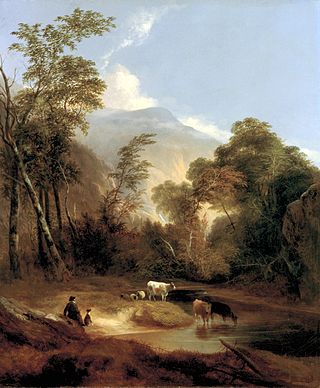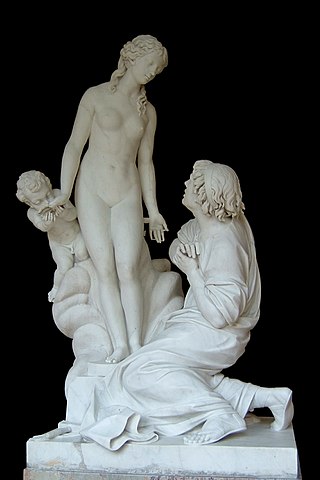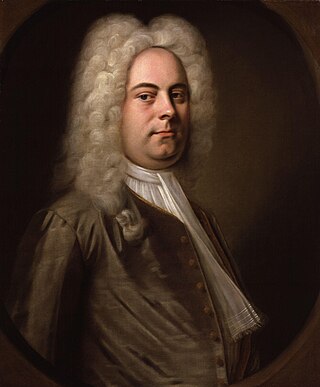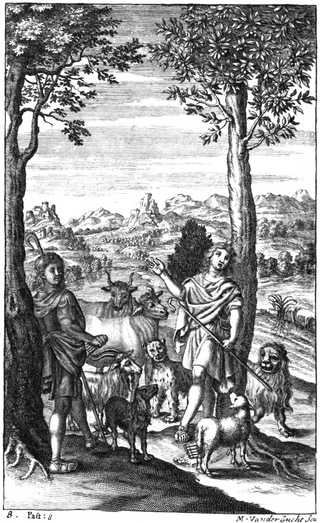Related Research Articles

Polyphemus is the one-eyed giant son of Poseidon and Thoosa in Greek mythology, one of the Cyclopes described in Homer's Odyssey. His name means "abounding in songs and legends", "many-voiced" or "very famous". Polyphemus first appeared as a savage man-eating giant in the ninth book of the Odyssey. The satyr play of Euripides is dependent on this episode apart from one detail; Polyphemus is made a pederast in the play. Later Classical writers presented him in their poems as heterosexual and linked his name with the nymph Galatea. Often he was portrayed as unsuccessful in these, and as unaware of his disproportionate size and musical failings. In the work of even later authors, however, he is presented as both a successful lover and skilled musician. From the Renaissance on, art and literature reflect all of these interpretations of the giant.

In Greek mythology, Daphnis was a legendary Sicilian cowherd who was said to be the inventor of pastoral poetry. According to Diodorus the Sicilian, Daphnis was born in the Heraean Mountains of central Sicily.

Callimachus was an ancient Greek poet, scholar and librarian who was active in Alexandria during the 3rd century BC. A representative of Ancient Greek literature of the Hellenistic period, he wrote over 800 literary works in a wide variety of genres, most of which did not survive. He espoused an aesthetic philosophy, known as Callimacheanism, which exerted a strong influence on the poets of the Roman Empire and, through them, on all subsequent Western literature.

Theocritus was a Greek poet from Sicily, Magna Graecia, and the creator of Ancient Greek pastoral poetry.

The pastoral genre of literature, art, or music depicts an idealised form of the shepherd's lifestyle – herding livestock around open areas of land according to the seasons and the changing availability of water and pasture. The target audience is typically an urban one. A pastoral is a work of this genre. A piece of music in the genre is usually referred to as a pastorale.

Anyte of Tegea was a Hellenistic poet from Tegea in Arcadia. Little is known of her life, but twenty-four epigrams attributed to her are preserved in the Greek Anthology, and one is quoted by Julius Pollux; nineteen of these are generally accepted as authentic. She introduced rural themes to the genre, which became a standard theme in Hellenistic epigrams. She is one of the nine outstanding ancient women poets listed by Antipater of Thessalonica in the Palatine Anthology. Her pastoral poetry may have influenced Theocritus, and her works were adapted by several later poets, including Ovid.

Galatea is a name popularly applied to the statue carved of ivory by Pygmalion of Cyprus, which then came to life in Greek mythology.

The Eclogues, also called the Bucolics, is the first of the three major works of the Latin poet Virgil.

Acis and Galatea is a musical work by George Frideric Handel with an English text by John Gay. The work has been variously described as a serenata, a masque, a pastoral or pastoral opera, a "little opera", an entertainment and by the New Grove Dictionary of Music as an oratorio. The work was originally devised as a one-act masque which premiered in 1718.

Acis and Galatea are characters from Greek mythology later associated together in Ovid's Metamorphoses. The episode tells of the love between the mortal Acis and the Nereid (sea-nymph) Galatea; when the jealous Cyclops Polyphemus kills Acis, Galatea transforms her lover into an immortal river spirit. The episode was made the subject of poems, operas, paintings, and statues in the Renaissance and after.
La Fábula de Polifemo y Galatea, or simply the Polifemo, is a literary work written by Spanish poet Luis de Góngora y Argote. The poem, though borrowing heavily from prior literary sources of Greek and Roman Antiquity, attempts to go beyond the established versions of the myth by reconfiguring the narrative structure handed down by Ovid. Through the incorporation of highly innovative poetic techniques, Góngora effectively advances the background story of Acis and Galatea’s infatuation as well as the jealousy of the Cyclops Polyphemus.

Philitas of Cos, sometimes spelled Philetas, was a Greek scholar, poet and grammarian during the early Hellenistic period of ancient Greece. He is regarded as the founder of the Hellenistic school of poetry, which flourished in Alexandria after about 323 BC. Philitas is also reputed to have been the tutor of Ptolemy II Philadelphus and the poet Theocritus. He was thin and frail; Athenaeus later caricatured him as an academic so consumed by his studies that he wasted away and died.
Idyll XI, otherwise known as Bucolic poem 11, was written by Theocritus in dactylic hexameter. Its main character, the Cyclops Polyphemus, has appeared in other works of literature such as Homer's Odyssey, and Theocritus' Idyll VI.
Kathryn J. Gutzwiller is a professor of classics at the University of Cincinnati. She specialises in Hellenistic poetry, and her interests include Greek and Latin poetry, ancient gender studies, literary theory, and the interaction between text and image. Her contribution to Hellenistic epigram and pastoral poetry has been considered particularly influential.
Idyll I, sometimes called Θύρσις ('Thyrsis'), is a bucolic poem by the 3rd-century BC Greek poet Theocritus which takes the form of a dialogue between two rustics in a pastoral setting. Thyrsis meets a goatherd in a shady place beside a spring, and at his invitation sings the story of Daphnis. This ideal hero of Greek pastoral song had won for his bride the fairest of the Nymphs. Confident in the strength of his passion, he boasted that Love could never subdue him to a new affection. Love avenged himself by making Daphnis desire a strange maiden, but to this temptation he never yielded, and so died a constant lover. The song tells how the cattle and the wild things of the wood bewailed him, how Hermes and Priapus gave him counsel in vain, and how with his last breath he retorted the taunts of Aphrodite.

Eclogue 2 is a pastoral poem by the Latin poet Virgil, one of a series of ten poems known as the Eclogues. In this Eclogue the herdsman Corydon laments his inability to win the affections of the young Alexis. It is an imitation of the eleventh Idyll of Theocritus, in which the Cyclops Polyphemus laments the cruelty of the sea-nymph Galatea. After a 5-line introduction, the rest of the poem consists of a single speech by Corydon. The poem has 73 lines, and is written in the dactylic hexameter metre.

Eclogue 3 is a pastoral poem by the Latin poet Virgil, one of a collection of ten poems known as the "Eclogues". This eclogue represents the rivalry in song of two herdsmen, Menalcas and Damoetas. After trading insults, the two men decide to have a singing competition, for which each offers a prize. A neighbour, Palaemon, who comes along by chance, agrees to be the judge. The second half of the poem consists of the contest, in which each of the two competitors in turn sings a couplet and the other caps it with another couplet. In the end Palaemon brings the contest to an end and declares it a draw.

Eclogue 8, also titled Pharmaceutria, is a pastoral poem by the Latin poet Virgil, one of his book of ten Eclogues. After an introduction, containing an address to an unnamed dedicatee, there follow two love songs of equal length sung by two herdsmen, Damon and Alphesiboeus. One is the song of a love-sick young man, whose girlfriend Nysa is marrying another man, Mopsus. The second is the song of a woman who, with the help of her servant Amaryllis, is performing a magic rite to try to entice her beloved Daphnis back from the city.

Eclogue 9 is a pastoral poem by the Latin poet Virgil, one of his series of ten poems known as the Eclogues. This eclogue describes the meeting of two countrymen Lycidas and Moeris. Moeris has been turned out of his farm and is taking some kid goats to town for the new occupant; young Lycidas is astonished, for he had heard that Menalcas had secured the safety of the district by his poetry, but Moeris replies that, so far from that being so, he and Menalcas himself had barely escaped with their lives: they then proceed to recall passages of Menalcas' poetry. Lycidas wants to continue singing to lighten the journey but the distressed Moeris begs him to cease, promising that they will sing again when Menalcas returns.
Idyll VIII, also called Βουκολιασταί βʹ, is a bucolic poem by the 3rd-century BC Greek poet Theocritus.
References
- ↑ Halperin, David M. (1983). Before Pastoral: Theocritus and the Ancient Tradition of Bucolic Poetry. Yale University Press.
- ↑ Lawall, Gilbert (1967). Theocritus' Coan Pastorals . Washington, D.C.: The Center For Hellenic Studies.
- ↑ Lawall, Gilbert (1967). Theocritus' Coan Pastorals . Washington, D.C.: The Center For Hellenic Studies.
- ↑ Lawall, Gilbert (1967). Theocritus' Coan Pastorals . Washington, D.C.: The Center For Hellenic Studies.
- ↑ Lawall, Gilbert (1967). Theocritus' Coan Pastorals . Washington, D.C.: The Center For Hellenic Studies.
- ↑ Lawall, Gilbert (1967). Theocritus' Coan Pastorals . Washington, D.C.: The Center For Hellenic Studies.
- ↑ Lawall, Gilbert (1967). Theocritus' Coan Pastorals . Washington, D.C.: The Center For Hellenic Studies.
- ↑ Gutzwiller, Kathryn J. (1991). Theocritus' pastoral analogies: the formation of a genre. 125: University of Wisconsin Press.
{{cite book}}: CS1 maint: location (link) - ↑ Gutzwiller, Kathryn J. (1991). Theocritus' pastoral analogies: the formation of a genre. 129: University of Wisconsin Press.
{{cite book}}: CS1 maint: location (link) - ↑ Gutzwiller, Kathryn J. (1991). Theocritus' pastoral analogies: the formation of a genre. 129: University of Wisconsin Press.
{{cite book}}: CS1 maint: location (link) - ↑ Gutzwiller, Kathryn J. (1991). Theocritus' pastoral analogies: the formation of a genre. 129: University of Wisconsin Press.
{{cite book}}: CS1 maint: location (link)